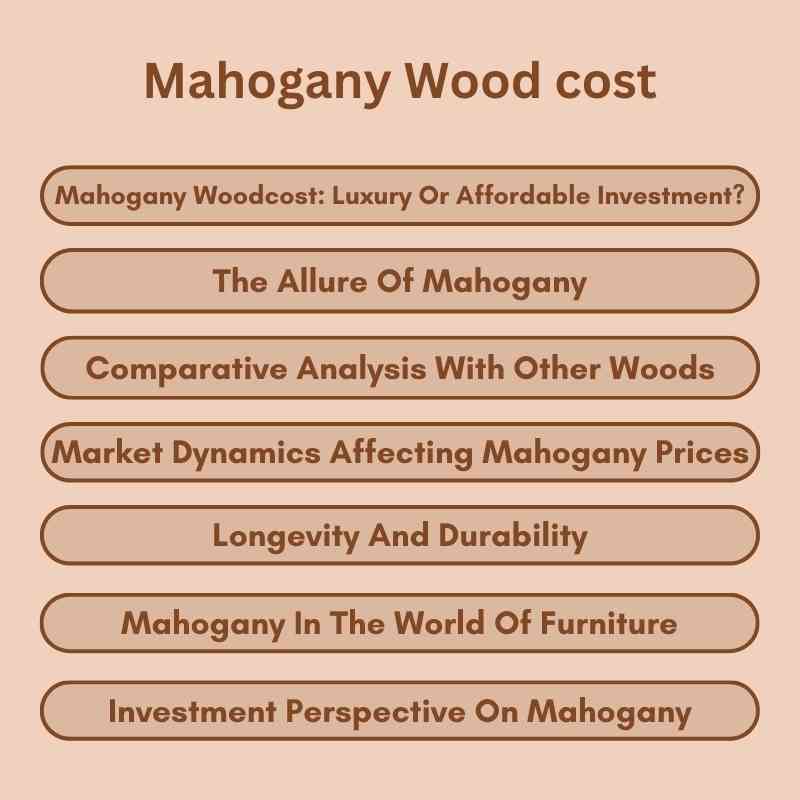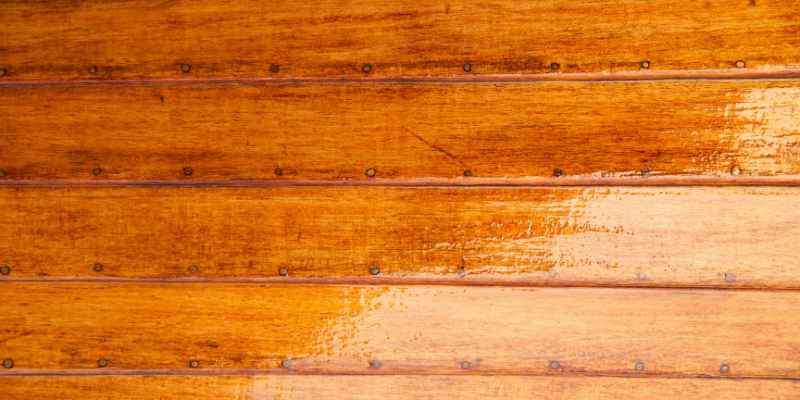Mahogany wood typically costs between $8 to $15 per board foot, depending on quality and source. Prices can fluctuate based on market demand and availability.
Mahogany wood is highly sought after for its rich color and durability. This hardwood is popular in furniture making, cabinetry, and boat building due to its natural resistance to moisture and insects. Its fine grain and smooth texture make it ideal for high-end applications.
Many artisans and manufacturers appreciate mahogany for its ease of workability and longevity. As a premium material, mahogany’s price reflects its quality and desirability. Understanding the factors that influence its cost can help you make informed decisions when purchasing. Whether you’re a DIY enthusiast or a professional, knowing the price range is essential for budgeting your projects effectively.
Mahogany Woodcost: Luxury Or Affordable Investment?
Mahogany wood is known for its beauty and durability. Many people wonder about its cost. Is it a luxury or an affordable investment? Let’s explore.
Understanding Mahogany Wood Prices
Mahogany prices vary based on several factors. Here are the main ones:
- Quality: Higher quality means higher prices.
- Source: Different regions have different costs.
- Supply and Demand: Limited supply raises prices.
- Processing: More processing leads to higher costs.
Average Cost Of Mahogany Wood
The average cost of mahogany wood can range widely. Here’s a table showing typical prices:
| Wood Type | Cost per Board Foot |
|---|---|
| Mahogany (Sapele) | $6 – $10 |
| Mahogany (Honduran) | $10 – $20 |
| Mahogany (Philippine) | $8 – $15 |
Is Mahogany A Luxury Item?
Many see mahogany as a luxury wood. Here are reasons why:
- Rich color and fine grain.
- Resistant to moisture and pests.
- Long-lasting and age beautifully.
- High demand in furniture and cabinetry.
Is Mahogany An Affordable Investment?
Investing in mahogany can be wise. Here’s why:
- Durability: It lasts for decades.
- Value: Holds value over time.
- Versatility: Suitable for many projects.
- Aesthetic Appeal: Enhances any space.
Many consider mahogany both luxurious and an investment. The cost reflects its unique qualities.

The Allure Of Mahogany
Mahogany wood has captivated people for centuries. Its rich color and durability make it a favorite choice for furniture and decor. This wood stands out for its beauty and strength, making it a timeless material.
Historical Significance
Mahogany wood has a long and fascinating history. It became popular in the 18th century among European artisans. They prized it for its fine grain and deep hues.
- Colonial Era: Mahogany was widely used in furniture making.
- Craftsmanship: Skilled craftsmen created intricate designs.
- Trade: It became a valuable commodity in international trade.
Many historic pieces still exist today, showcasing the artistry of that time. Mahogany reflects a rich heritage that adds value to any item made from it.
Aesthetic Appeal
The visual charm of mahogany is undeniable. Its warm, reddish-brown color attracts many. The smooth texture enhances its appeal, making it perfect for various designs.
| Feature | Description |
|---|---|
| Color | Rich reddish-brown that deepens over time. |
| Grain | Fine, straight grain adds elegance. |
| Finish | Polishes beautifully, enhancing its natural luster. |
Mahogany suits both classic and modern designs. Its versatility allows it to blend seamlessly into any style. From furniture to cabinetry, mahogany remains a preferred choice.
Breaking Down The Cost Factors
Understanding the cost of Mahogany wood requires examining several key factors. Each element contributes to its overall price. Let’s explore the main cost factors involved.
Harvesting And Sourcing
The first step in the cost of Mahogany wood is harvesting. This process involves:
- Identifying the right trees.
- Using specialized equipment for cutting.
- Transporting the wood to processing facilities.
Sourcing is also crucial. Mahogany grows in tropical regions. Limited availability increases the price. Countries like:
- Brazil
- Cuba
- Mexico
are known for their high-quality Mahogany. Sustainable practices can raise costs but ensure long-term availability.
Processing And Craftsmanship
After harvesting, the wood undergoes processing. This involves:
- Drying the wood to prevent warping.
- Cutting it into desired shapes and sizes.
- Finishing touches like sanding and staining.
High-quality craftsmanship adds significant value. Skilled artisans create beautiful pieces. They ensure:
- Durability
- Fine details
- Unique designs
These elements greatly influence the final price of Mahogany wood products.
| Cost Factor | Impact on Price |
|---|---|
| Harvesting | High due to labor and equipment |
| Sourcing | Limited availability increases cost |
| Processing | Quality control raises price |
| Craftsmanship | Skilled labor adds premium |
Comparative Analysis With Other Woods
Understanding the cost of Mahogany wood involves comparing it with other popular types of wood. Different woods have unique properties, aesthetics, and prices. This section focuses on two main contenders: Oak and Teak.
Oak Versus Mahogany
Oak is a common choice for furniture and flooring. Its durability and strength make it popular. However, it differs significantly from Mahogany in several aspects:
| Feature | Oak | Mahogany |
|---|---|---|
| Cost | Lower ($3-$7 per board foot) | Higher ($8-$15 per board foot) |
| Color | Light to medium brown | Rich, deep reddish-brown |
| Grain Pattern | Open grain, prominent | Fine, straight grain |
| Durability | Very durable | Highly durable |
Mahogany stands out for its rich color and fine grain. Oak is more affordable but less visually appealing for high-end furniture.
Teak Versus Mahogany
Teak is known for its water resistance. This quality makes it ideal for outdoor furniture. Below is a comparison of Teak and Mahogany:
| Feature | Teak | Mahogany |
|---|---|---|
| Cost | Higher ($10-$20 per board foot) | High ($8-$15 per board foot) |
| Color | Golden-brown | Deep reddish-brown |
| Grain Pattern | Straight, with occasional waves | Fine, straight |
| Resistance | Highly resistant to moisture | Moderate moisture resistance |
Teak offers excellent water resistance. Mahogany provides a rich aesthetic appeal. Both woods have higher price points, but they serve different purposes.
Market Dynamics Affecting Mahogany Prices
The price of mahogany wood is influenced by various market dynamics. Understanding these factors is crucial for buyers and sellers. The two main factors are supply and demand, and trade regulations. Each of these factors can greatly affect mahogany prices.
Supply And Demand
Supply and demand play a vital role in determining mahogany prices. When demand rises, prices often increase. Conversely, if supply exceeds demand, prices may drop.
- High Demand: Luxury furniture and flooring drive demand.
- Limited Supply: Deforestation and conservation efforts limit availability.
- Market Trends: Trends in interior design also affect demand.
Here’s a simple table showing how supply and demand interact:
| Condition | Price Effect |
|---|---|
| High Demand, Low Supply | Prices Increase |
| Low Demand, High Supply | Prices Decrease |
Trade Regulations
Trade regulations significantly impact mahogany pricing. These regulations can restrict or promote the trade of mahogany.
- Export Restrictions: Some countries limit mahogany exports.
- CITES Regulations: International laws protect specific mahogany species.
- Tariffs and Taxes: These can raise costs for importers.
Understanding these regulations helps buyers navigate the market effectively. Staying informed can lead to better purchasing decisions.
Longevity And Durability
Mahogany wood is known for its impressive longevity and durability. This makes it a popular choice for furniture and flooring. Its natural properties ensure it withstands the test of time.
Resistance To Decay And Pests
Mahogany wood has a strong resistance to decay. This resistance helps it last longer in various environments. Here are some key points:
- Natural oils in mahogany deter pests.
- It resists moisture, preventing rot.
- Durable against harsh weather conditions.
These features make mahogany ideal for outdoor furniture. Users can enjoy long-lasting beauty without frequent replacements.
Maintenance Costs
While mahogany wood is durable, it still requires some care. Regular maintenance keeps it looking great. Here’s what to consider:
| Maintenance Task | Frequency | Estimated Cost |
|---|---|---|
| Cleaning | Monthly | Low |
| Sealing | Every 2-3 years | Moderate |
| Repairing scratches | As needed | Variable |
Investing in maintenance ensures mahogany wood lasts. Regular care prevents costly repairs in the future.
Mahogany In The World Of Furniture
Mahogany wood stands out in the furniture industry. Its rich color and durability make it highly sought after. This premium wood adds elegance to any space. Many homeowners and designers favor it for crafting stunning furniture pieces.
High-end Furniture Market
The high-end furniture market thrives on quality and craftsmanship. Mahogany is a top choice for luxury items. Here are some key reasons why:
- Durability: Mahogany is strong and resistant to wear.
- Beauty: Its deep, warm tones add sophistication.
- Versatility: It suits various styles, from classic to modern.
Many brands use mahogany for:
- Tables
- Chairs
- Cabinets
- Dressers
These pieces often come with a higher price tag. Buyers expect quality and longevity. Investing in mahogany can yield beautiful returns.
Cost-benefit For Homeowners
Homeowners weigh cost against benefits. Mahogany offers long-term value. Here are some factors to consider:
| Feature | Mahogany | Other Woods |
|---|---|---|
| Longevity | High | Medium |
| Maintenance | Low | High |
| Resale Value | High | Low |
Investing in mahogany provides:
- Less frequent need for replacement
- Lower maintenance costs
- Higher resale value
Choosing mahogany means investing in quality. Homeowners enjoy both beauty and practicality.
Investment Perspective On Mahogany
Investing in mahogany wood offers unique benefits. This exotic timber is not just beautiful. It also has strong market demand. Understanding its value is key for potential investors.
Appreciation Potential
Mahogany wood has a high appreciation potential. Here are some factors that affect its value:
- Rarity: As it becomes scarce, prices rise.
- Quality: High-quality mahogany always commands a premium.
- Trends: Demand for sustainable materials boosts its appeal.
Investors may see significant returns over time. Historical data shows steady price increases. This trend makes it a solid choice for long-term investment.
Liquidity Considerations
Liquidity is important in any investment. Mahogany wood can be less liquid than stocks or bonds. Here are some liquidity points to consider:
| Factor | Description |
|---|---|
| Market Demand | Strong demand leads to quicker sales. |
| Quality and Grade | Higher grades sell faster than lower grades. |
| Sales Platforms | Online marketplaces can enhance liquidity. |
Consider these factors before investing. Understanding liquidity helps manage risks. A well-researched approach can lead to successful investments.
Sustainable Sourcing And Environmental Impact
Sourcing mahogany wood sustainably is crucial for our planet. It ensures forests remain healthy and vibrant. Responsible practices protect wildlife and ecosystems. Understanding the impact of mahogany sourcing helps consumers make better choices.
Certified Sustainable Mahogany
Certified sustainable mahogany comes from well-managed forests. These forests follow strict guidelines to protect nature. Many organizations certify sustainable wood. Look for certifications like:
- Forest Stewardship Council (FSC)
- Programme for the Endorsement of Forest Certification (PEFC)
- Rainforest Alliance
Buying certified mahogany supports:
- Forest conservation
- Wildlife protection
- Fair labor practices
Certified wood reduces illegal logging. It helps maintain biodiversity. Consumers can feel good about their purchase.
Eco-friendly Alternatives
Many eco-friendly alternatives exist for mahogany wood. These options provide similar beauty and durability. Consider using:
- Bamboo – Fast-growing and renewable
- Reclaimed wood – Reuses old materials
- Birch – Affordable and versatile
- Maple – Strong and attractive
These alternatives help protect forests. They reduce the demand for mahogany. Choosing these options supports a healthier environment.
| Wood Type | Benefits |
|---|---|
| Bamboo | Fast growth, renewable resource |
| Reclaimed wood | Eco-friendly, unique character |
| Birch | Affordable, easy to work with |
| Maple | Durable, attractive finish |
Choosing eco-friendly options supports sustainability. Protect forests for future generations. Every choice counts towards a healthier planet.
Final Thoughts: Balancing Cost And Quality
Choosing Mahogany wood involves considering both cost and quality. This beautiful wood is known for its rich color and durability. Finding the right balance is essential for buyers.
Making An Informed Decision
Before purchasing Mahogany, weigh the following factors:
- Budget: Know your spending limit.
- Quality: Assess the wood’s grade. Higher grades cost more.
- Source: Consider if the wood is sustainably harvested.
- Usage: Identify how you will use the wood.
Here’s a quick comparison of Mahogany grades:
| Grade | Characteristics | Price Range (per board foot) |
|---|---|---|
| FAS (First and Seconds) | Highest quality, minimal defects | $8 – $15 |
| Select | Good quality, some defects allowed | $5 – $10 |
| Common | Lower quality, more defects | $3 – $6 |
Future Trends In Wood Pricing
Wood prices are affected by many factors. Here are some trends to watch:
- Sustainability: Demand for sustainably sourced wood is rising.
- Market fluctuations: Prices may vary based on supply and demand.
- Import tariffs: Changes in tariffs can impact costs.
- Environmental regulations: Stricter rules may affect availability.
Understanding these trends helps buyers make wise choices. Always stay informed about market changes to get the best value.

Frequently Asked Questions
What Is The Average Cost Of Mahogany Wood?
The average cost of mahogany wood varies based on quality and source. Typically, it ranges from $8 to $20 per board foot. Factors like availability and market demand can influence these prices. Always check local suppliers for the most accurate pricing.
How Does Mahogany Wood Compare In Price To Oak?
Mahogany wood is generally more expensive than oak. While oak costs between $4 to $10 per board foot, mahogany’s premium quality justifies its higher price. Mahogany’s unique color and durability make it a sought-after choice for high-end furniture and cabinetry.
What Factors Affect Mahogany Wood Pricing?
Several factors affect mahogany wood pricing, including supply and demand, quality, and source. Sustainability practices also play a role. Imported mahogany may cost more due to shipping and tariffs. Finally, regional availability can significantly impact local prices.
Is Mahogany Wood Worth The Cost?
Yes, mahogany wood is often worth the cost due to its durability and aesthetic appeal. Its rich color and fine grain enhance furniture and cabinetry. Additionally, mahogany ages beautifully, making it a long-term investment for quality craftsmanship and design.
Conclusion
Understanding Mahogany wood costs is essential for making informed purchasing decisions. This beautiful and durable material offers great value for furniture and decor. By considering factors like quality and sourcing, you can find the right pieces for your needs. Invest wisely, and enjoy the timeless elegance that Mahogany brings to your space.

